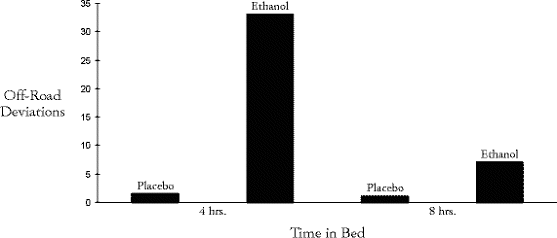
Alcohol Consumption
Consumption of alcohol interacts with sleepiness to increase drowsiness and impairment
Although sleepiness and alcohol are distinct crash causes, the data also show some evidence of overlap. NHTSA found that drivers had consumed some alcohol in nearly 20% of all sleepiness-related, single-vehicle crashes (Wang, Knipling, Goodman, 1996). More than one in three New York State drivers surveyed in drowsy-driving crashes said they had drunk some alcohol (McCartt et al., 1996), and police-reported "fall-asleep" crashes had a higher proportion of alcohol involvement than other types of crashes in that state. (New York GTSC Task Force, 1994; New York State Task Force, 1996).
Laboratory studies explain and predict these patterns. Many researchers have shown that sleepiness and alcohol interact, with sleep restriction exacerbating the sedating effects of alcohol, and the combination adversely affecting psychomotor skills to an extent greater than that of sleepiness or alcohol alone (Roehrs et al. 1994; Wilkinson, 1968; Huntley, Centybear, 1974; Peeke et al., 1980). Driving simulation tests specifically show this effect, even with modest reductions in sleep, low alcohol doses, and low blood/ethanol concentrations. In a driving simulation study, alcohol levels below the legal driving limit produced a greater number of deviations from the road after four hours of sleep than after eight hours of sleep (Roehrs et al., 1994) (see figure 4)
 Figure 4. Interaction between alcohol and sleepiness. These data from Roehrs et al. (1994) were collected in a laboratory using a driving simulator. Studies were performed in the morning after either 8 hours or 4 hours of time in bed the previous night and with either a low dose of ethanol or placebo. The number of off-road deviations by the driver was four times higher after eight hours of sleep time but 15 times higher with only four hours of sleep time.
Figure 4. Interaction between alcohol and sleepiness. These data from Roehrs et al. (1994) were collected in a laboratory using a driving simulator. Studies were performed in the morning after either 8 hours or 4 hours of time in bed the previous night and with either a low dose of ethanol or placebo. The number of off-road deviations by the driver was four times higher after eight hours of sleep time but 15 times higher with only four hours of sleep time.
It is possible that the effects of low levels of blood alcohol may have an interaction with circadian rhythms that produce sleepiness in the afternoon and evening (Roehrs et al., 1994; Horne, Baumber, 1991; Horne, Gibbons, 1991). The panel speculated that drinking alcohol before driving in the afternoon or at night might pose special risks given the circadian effects.
Although sleepiness and alcohol are distinct crash causes, the data also show some evidence of overlap. NHTSA found that drivers had consumed some alcohol in nearly 20% of all sleepiness-related, single-vehicle crashes (Wang, Knipling, Goodman, 1996). More than one in three New York State drivers surveyed in drowsy-driving crashes said they had drunk some alcohol (McCartt et al., 1996), and police-reported "fall-asleep" crashes had a higher proportion of alcohol involvement than other types of crashes in that state. (New York GTSC Task Force, 1994; New York State Task Force, 1996).
Laboratory studies explain and predict these patterns. Many researchers have shown that sleepiness and alcohol interact, with sleep restriction exacerbating the sedating effects of alcohol, and the combination adversely affecting psychomotor skills to an extent greater than that of sleepiness or alcohol alone (Roehrs et al. 1994; Wilkinson, 1968; Huntley, Centybear, 1974; Peeke et al., 1980). Driving simulation tests specifically show this effect, even with modest reductions in sleep, low alcohol doses, and low blood/ethanol concentrations. In a driving simulation study, alcohol levels below the legal driving limit produced a greater number of deviations from the road after four hours of sleep than after eight hours of sleep (Roehrs et al., 1994) (see figure 4)

It is possible that the effects of low levels of blood alcohol may have an interaction with circadian rhythms that produce sleepiness in the afternoon and evening (Roehrs et al., 1994; Horne, Baumber, 1991; Horne, Gibbons, 1991). The panel speculated that drinking alcohol before driving in the afternoon or at night might pose special risks given the circadian effects.







